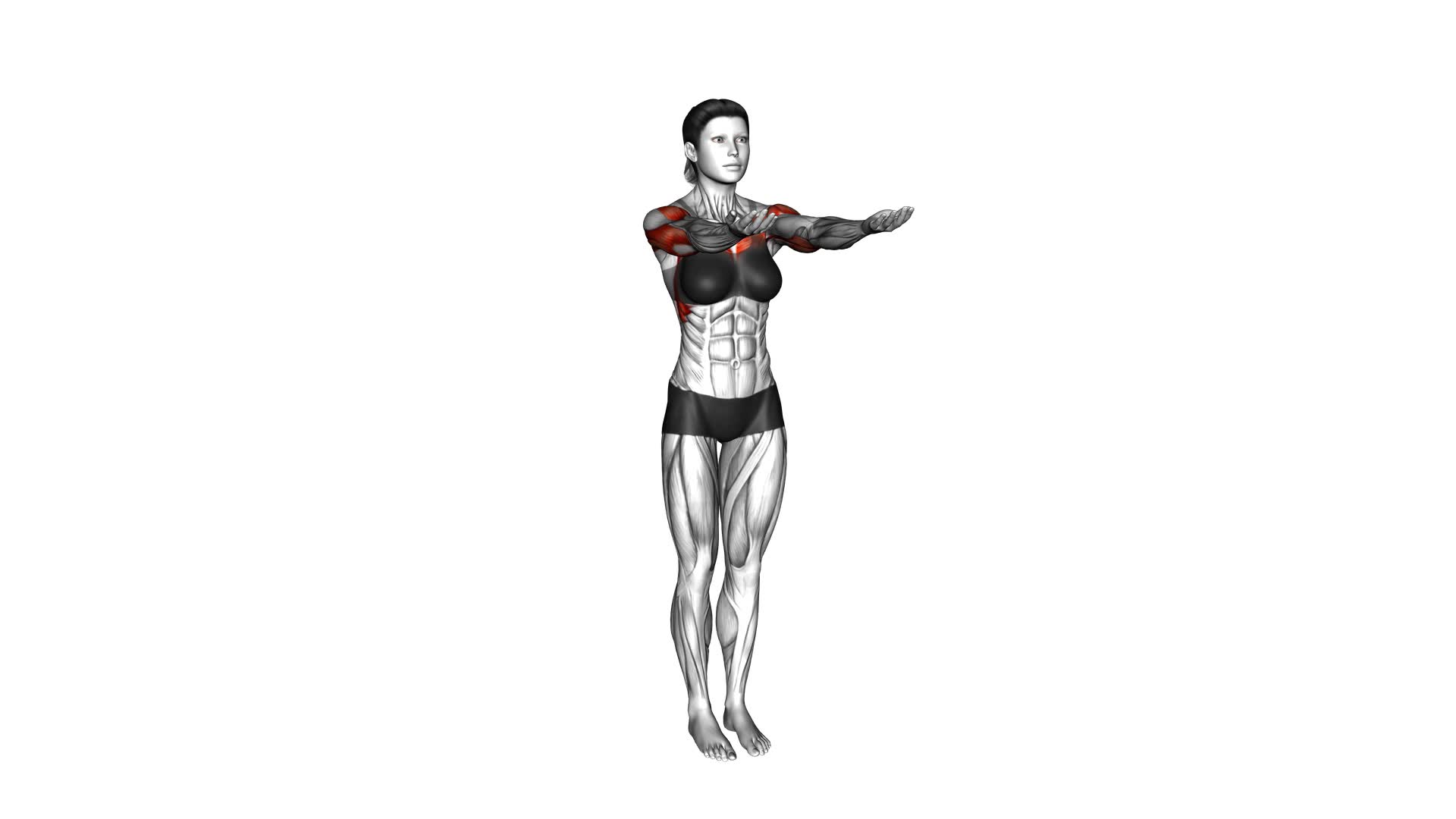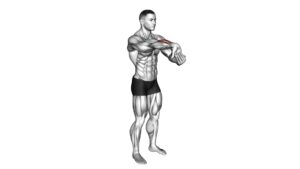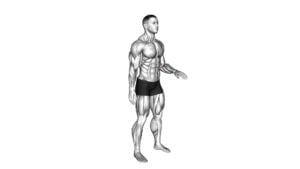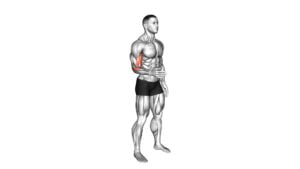Forearm Push Forward (female) – Video Exercise Guide & Tips

In this video exercise guide, you'll learn how to perform the forearm push forward exercise. This movement targets your forearm muscles and can help improve your upper body strength.
Watch This Exercise Video
You'll discover the proper form and technique, as well as beginner modifications and progressions.
We'll also cover common mistakes to avoid and provide tips for maximizing your forearm push forward workout.
Get ready to strengthen and sculpt your arms with this effective exercise.
Let's dive in!
Key Takeaways
- Increased forearm strength
- Enhanced wrist stability
- Improved coordination and control
- Incorporate modifications and progressions
Benefits of Forearm Push Forward
You can experience numerous benefits from incorporating forearm push forward exercises into your workout routine. These exercises specifically target the muscles in your forearms, offering a range of advantages. One of the key benefits is increased forearm strength. By regularly performing forearm push forwards, you can effectively build up the muscles in your forearms, improving your grip strength and overall upper body strength.
Another benefit is enhanced wrist stability. The forearm push forward exercises engage the muscles that support your wrists, helping to stabilize and strengthen them. This can be particularly beneficial for individuals who engage in activities that require repetitive wrist movements, such as typing or playing a musical instrument.
In addition to strength and stability, forearm push forward exercises can also improve your overall coordination and control. The movements involved in these exercises require a high level of precision and coordination between your forearms and wrists, helping to enhance your motor skills and proprioception.
To maximize the benefits of forearm push forward exercises, you can incorporate modifications and progressions. For beginners, starting with lighter weights or resistance bands can help build strength gradually. As you progress, you can increase the intensity by using heavier weights or adjusting the angle of the exercise.
Proper Form and Technique
To perform the forearm push forward exercise correctly, follow these steps.
Start by standing with your feet shoulder-width apart and your knees slightly bent.
Hold a dumbbell in each hand, with your palms facing up and your elbows bent at a 90-degree angle.
Keep your core engaged and your back straight throughout the exercise.
Begin by extending your forearms forward, keeping your elbows close to your body.
As you push the dumbbells forward, exhale and focus on squeezing your triceps.
Pause for a second at full extension, and then slowly return to the starting position.
Repeat for the desired number of repetitions.
To ensure proper form and technique, it's important to avoid common mistakes.
One common mistake is allowing your elbows to flare out to the sides.
Keep your elbows close to your body throughout the movement to target your triceps effectively.
Another mistake is using momentum to push the dumbbells forward.
Instead, focus on using your triceps to control the movement.
To improve your form, try using lighter weights and focusing on the mind-muscle connection.
This will help you engage your triceps more effectively.
Additionally, make sure to maintain a slow and controlled pace throughout the exercise.
In the next section, we'll discuss the equipment needed for the forearm push forward exercise.
Equipment Needed for the Exercise
The equipment required for the forearm push forward exercise includes dumbbells and a sturdy stance. Dumbbells are recommended for this exercise as they allow for better control and targeting of the forearm muscles. When choosing dumbbells, it's important to select a weight that challenges you without causing strain or compromising your form.
To choose the right weight for the forearm push forward exercise, start with a weight that you can comfortably lift for 8 to 12 repetitions. This weight should provide a moderate level of resistance without causing excessive fatigue. As you become stronger and more comfortable with the exercise, you can gradually increase the weight to continue challenging your muscles.
It is essential to maintain proper form throughout the exercise, so it's crucial to choose a weight that allows you to do so. If you find yourself struggling to lift the weight or experiencing pain or discomfort, it may be a sign that the weight is too heavy for you. Conversely, if the weight feels too light and you can easily complete the repetitions without feeling any resistance, it may be time to increase the weight.
Beginner Modifications and Progressions
If you're just starting out with the forearm push forward exercise, there are some easier options you can try to build up your strength and technique.
As you progress, you can gradually increase the difficulty level by adding more resistance or trying more challenging variations.
It's important to modify the exercise based on your abilities to ensure proper form and avoid injury.
Easier Exercise Options
Start with modified versions of the forearm push forward exercise to make it easier for beginners. Here are some alternative exercises and easier modifications that you can try:
- Forearm Plank: Start by holding a plank position on your forearms instead of pushing forward. This helps build core strength and stability without the movement.
- Wall Push: Stand facing a wall and place your hands on it at shoulder height. Push against the wall, using your forearms, to engage your chest and shoulder muscles.
- Knee Push: Perform the forearm push forward exercise while on your knees instead of your toes. This reduces the amount of body weight you have to push and makes it easier to control the movement.
- Resistance Band Push: Attach a resistance band to a stable anchor point and hold the ends in your hands. Push forward against the resistance of the band to work your chest and arms.
Advancing Difficulty Levels
To progress in difficulty levels for the forearm push forward exercise, focus on gradual intensification and challenging variations.
As you become more comfortable with the basic movement, you can start incorporating progression levels to continue challenging your muscles and improving your strength.
One way to do this is by increasing the number of repetitions or sets you perform. For example, you can start with 3 sets of 10 reps and gradually increase to 4 sets of 15 reps.
Additionally, you can try advanced variations of the exercise to further enhance its difficulty. These variations may include using resistance bands, adding weights, or performing the exercise on an unstable surface, such as a stability ball.
Remember to always listen to your body and progress at a pace that feels comfortable yet challenging for you.
Modifying for Different Abilities
Continuing to modify the forearm push forward exercise for different abilities, focus on incorporating beginner modifications and progressions to gradually increase the challenge and effectiveness of the workout. Here are some tips to adapt the exercise for individuals with injuries or older adults:
Adapting for injuries:
- Reduce range of motion: Shorten the movement to avoid exacerbating the injury.
- Use a lighter resistance band: Decrease the tension on the band to reduce strain on the injured area.
- Seek professional guidance: Consult with a physical therapist or trainer for personalized modifications.
Modifying for older adults:
- Decrease resistance: Start with a lighter band and gradually increase as strength improves.
- Slow down the movement: Focus on controlled, deliberate motions to ensure safety and proper form.
- Use a chair for support: Place a chair behind you for stability during the exercise.
- Listen to your body: Stop if you experience any pain or discomfort and consult a healthcare professional.
Common Mistakes to Avoid
When performing the forearm push forward exercise, it's important to avoid common mistakes that can hinder your progress and lead to injury. One common mistake is having incorrect forearm position, which can put unnecessary strain on your wrists.
Another mistake to avoid is lack of proper form, such as arching your back or rounding your shoulders, as this can reduce the effectiveness of the exercise.
Finally, overexertion and muscle strain can occur if you push yourself too hard without allowing for proper rest and recovery.
Incorrect Forearm Position
Avoid placing your forearms in an incorrect position while performing the forearm push forward exercise. Improper technique can lead to potential injuries and hinder your progress. Here are some common mistakes to avoid when it comes to forearm position:
- Placing your forearms too high:
Keep your forearms parallel to the ground, avoiding any upward or downward tilting.
- Allowing your wrists to bend:
Maintain a straight line from your forearm to your hand, avoiding any excessive bending or flexing of the wrists.
- Gripping the handles too tightly:
Maintain a relaxed grip to prevent tension in your forearms and wrists.
- Letting your elbows flare out:
Keep your elbows close to your body to engage the correct muscles and avoid strain on the joints.
Lack of Proper Form
One common mistake to avoid is gripping the handles too tightly during the forearm push forward exercise. Using improper technique can lead to injury and hinder your progress.
When performing this exercise, it's important to maintain a loose grip on the handles. Gripping too tightly can cause unnecessary strain on your wrists and forearms, increasing the risk of injury. Additionally, it can prevent you from engaging the correct muscles and achieving the desired results.
To prevent injuries and maximize the effectiveness of the exercise, focus on using a controlled and fluid motion, rather than relying on brute force. By mastering the proper form and technique, you can ensure a safe and effective forearm push forward exercise.
Overexertion and Muscle Strain
To prevent overexertion and muscle strain, it's important to maintain proper form and technique during the forearm push forward exercise. Here are some essential tips to help you avoid these common mistakes:
- Start with a warm-up: Before diving into the exercise, perform some stretching exercises to prepare your muscles for the movement.
- Gradually increase intensity: Avoid pushing yourself too hard too quickly. Increase the resistance or weight gradually to prevent overexertion and allow your muscles to adapt.
- Focus on your breathing: Proper breathing technique during the exercise can help prevent muscle strain. Breathe in as you push forward and exhale as you return to the starting position.
- Listen to your body: Pay attention to any discomfort or pain. If you feel any strain or excessive fatigue, take a break or modify the exercise to reduce the risk of injury.
By following these tips, you can prevent overexertion and muscle strain during your forearm push forward workout.
Now, let's move on to some tips for maximizing your forearm push forward workout.
Tips for Maximizing Your Forearm Push Forward Workout
Get the most out of your forearm push forward workout by incorporating these tips to maximize your results.
Maximizing forearm strength and improving your push forward technique is essential for an effective workout.
First, focus on proper form. Maintain a straight back and engage your core throughout the exercise. Keep your forearms parallel to the ground and your elbows at a 90-degree angle. This will ensure that you're targeting the correct muscles and reducing the risk of injury.
Next, gradually increase the resistance. Start with a weight that challenges you but still allows you to perform the exercise with proper form. As you become stronger, gradually increase the weight to continue challenging your muscles. This will help maximize your forearm strength and promote muscle growth.
Additionally, vary your grip. Experiment with different hand positions to target different areas of your forearm muscles. This will provide a more well-rounded workout and prevent muscle imbalances.
Finally, don't forget to warm up and cool down. Before starting your forearm push forward workout, perform dynamic stretches to warm up your muscles and increase blood flow. Afterward, perform static stretches to promote flexibility and prevent muscle soreness.
Frequently Asked Questions
How Many Calories Can Be Burned by Doing Forearm Push Forward Exercises?
Forearm push forward exercises are a great way to burn calories. By incorporating variations of forearm push forward movements into your workout routine, you can maximize calorie burn. These exercises engage multiple muscle groups, increasing your heart rate and energy expenditure.
Whether you're doing them with weights or using your body weight, forearm push forward exercises are an effective way to torch calories and build strength. Add them to your full body workout routine for optimal results.
Can Forearm Push Forward Exercises Help in Reducing Arm Fat?
Forearm push forward exercises can be effective in toning your arms by targeting the muscles in your forearms, biceps, and triceps. These exercises involve pushing your forearms forward against resistance, which helps to strengthen and define the muscles in your arms.
Additionally, forearm push forward exercises can also improve your grip strength, as they require you to engage your forearm muscles to maintain control and stability.
Incorporating these exercises into your workout routine can contribute to reducing arm fat and achieving leaner, more toned arms.
Is It Safe to Do Forearm Push Forward Exercises if I Have a Previous Wrist Injury?
If you have a previous wrist injury, it's important to consider your safety when doing forearm push forward exercises. These exercises may put strain on your injured wrist and hinder your rehabilitation process.
It's recommended to consult with a healthcare professional or a certified trainer for modifications and wrist-friendly exercises that won't aggravate your injury. Prioritizing your wrist's healing is crucial to avoid further damage and promote proper recovery.
How Many Sets and Repetitions Should I Do for an Effective Forearm Push Forward Workout?
For an effective forearm push forward workout, you should aim for an optimal training frequency of 2-3 times per week.
Start with 2 sets of 10-12 repetitions and gradually increase as you progress.
To add variation and challenge, you can try advanced forearm push forward variations like using resistance bands or performing the exercise on an unstable surface.
Remember to listen to your body and adjust the intensity as needed to avoid any further wrist injuries.
Are There Any Alternative Exercises That Can Target the Same Muscles as Forearm Push Forward?
Looking for alternative exercises that target the same muscles as forearm push forward?
There are a few options you can try. Wrist curls and reverse curls are great for strengthening your forearm muscles.
Farmer's walks and kettlebell swings also engage your forearms while working other muscle groups.
Remember, the forearm push forward exercise offers benefits like improved grip strength and wrist stability.
Exploring different exercises can help you add variety to your routine and maximize your gains.
Conclusion
In conclusion, the forearm push forward exercise is an effective way to strengthen and tone your forearm muscles.
By maintaining proper form and technique, using the necessary equipment, and avoiding common mistakes, you can maximize the benefits of this workout.
Whether you're a beginner or looking to progress, there are modifications available to suit your fitness level.
Remember to follow these tips and enjoy the advantages of incorporating forearm push forward into your exercise routine.

Author
Years ago, the spark of my life’s passion ignited in my mind the moment I stepped into the local gym for the first time. The inaugural bead of perspiration, the initial endeavor, the very first surge of endorphins, and a sense of pride that washed over me post-workout marked the beginning of my deep-seated interest in strength sports, fitness, and sports nutrition. This very curiosity blossomed rapidly into a profound fascination, propelling me to earn a Master’s degree in Physical Education from the Academy of Physical Education in Krakow, followed by a Sports Manager diploma from the Jagiellonian University. My journey of growth led me to gain more specialized qualifications, such as being a certified personal trainer with a focus on sports dietetics, a lifeguard, and an instructor for wellness and corrective gymnastics. Theoretical knowledge paired seamlessly with practical experience, reinforcing my belief that the transformation of individuals under my guidance was also a reflection of my personal growth. This belief holds true even today. Each day, I strive to push the boundaries and explore new realms. These realms gently elevate me to greater heights. The unique combination of passion for my field and the continuous quest for growth fuels my drive to break new ground.







